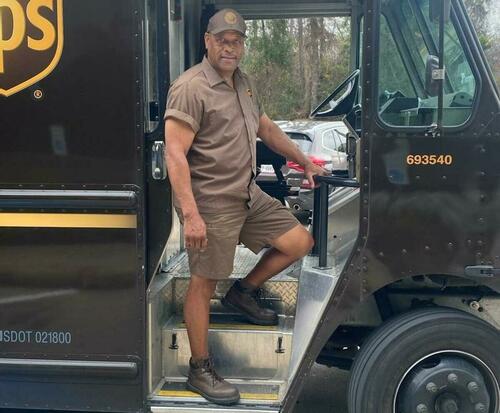
Unionized UPS workers ratified the Teamsters-negotiated labor deal reached last month, including wage increases, better working conditions, and air conditioners in all new package delivery vehicles. The five-year contract covers 340,000 employees and ends a labor standoff that could've crushed supply chains nationwide.
The agreement passed on Tuesday with the highest-ever contract vote in Teamsters' history at UPS:
"Today, Teamsters voted by an overwhelming 86.3 percent to ratify the most historic collective bargaining agreement in the history of UPS," the union wrote in a press release.
"Our members just ratified the most lucrative agreement the Teamsters have ever negotiated at UPS. This contract will improve the lives of hundreds of thousands of workers," said Teamsters General President Sean M. O'Brien.
O'Brien continued, "Teamsters have set a new standard and raised the bar for pay, benefits, and working conditions in the package delivery industry. This is the template for how workers should be paid and protected nationwide, and nonunion companies like Amazon better pay attention."
Teamsters General Secretary-Treasurer Fred Zuckerman said, "This is the richest national contract I've seen in my more than 40 years of representing Teamsters at UPS."
The new contract means the average full-time delivery driver makes $170,000 annually in pay and benefits, while part-time workers will make upwards of $21 per hour. As a result of the new contract, Americans are panic searching how to become a UPS driver.
Zuckerman said, "There are more gains in this contract than in any other UPS agreement and with no givebacks to the company. But the hard work doesn't end here. We will continue to fight like hell to enforce this contract and make sure UPS lives up to every word of it over the next five years."
The bad news is UPS slashed its full-year revenue and margin forecasts "primarily to reflect the volume impact from labor negotiations and the costs associated with the tentative agreement." Plus a souring outlook means the company won't be hiring en masse anytime soon.
Unionized UPS workers ratified the Teamsters-negotiated labor deal reached last month, including wage increases, better working conditions, and air conditioners in all new package delivery vehicles. The five-year contract covers 340,000 employees and ends a labor standoff that could’ve crushed supply chains nationwide.
The agreement passed on Tuesday with the highest-ever contract vote in Teamsters’ history at UPS:
“Today, Teamsters voted by an overwhelming 86.3 percent to ratify the most historic collective bargaining agreement in the history of UPS,” the union wrote in a press release.
“Our members just ratified the most lucrative agreement the Teamsters have ever negotiated at UPS. This contract will improve the lives of hundreds of thousands of workers,” said Teamsters General President Sean M. O’Brien.
O’Brien continued, “Teamsters have set a new standard and raised the bar for pay, benefits, and working conditions in the package delivery industry. This is the template for how workers should be paid and protected nationwide, and nonunion companies like Amazon better pay attention.”
Teamsters General Secretary-Treasurer Fred Zuckerman said, “This is the richest national contract I’ve seen in my more than 40 years of representing Teamsters at UPS.”
The new contract means the average full-time delivery driver makes $170,000 annually in pay and benefits, while part-time workers will make upwards of $21 per hour. As a result of the new contract, Americans are panic searching how to become a UPS driver.
Zuckerman said, “There are more gains in this contract than in any other UPS agreement and with no givebacks to the company. But the hard work doesn’t end here. We will continue to fight like hell to enforce this contract and make sure UPS lives up to every word of it over the next five years.”
The bad news is UPS slashed its full-year revenue and margin forecasts “primarily to reflect the volume impact from labor negotiations and the costs associated with the tentative agreement.” Plus a souring outlook means the company won’t be hiring en masse anytime soon.
Loading…







